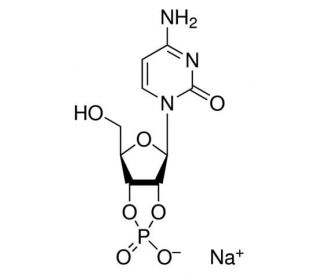

Cytidine 2′:3′-cyclic monophosphate monosodium salt (CAS 15718-51-1)
QUICK LINKS
Cytidine 2′:3′-cyclic monophosphate monosodium salt, a cyclic nucleotide, is a molecule that plays a significant role in various biochemical and molecular biology research applications. It is used to study RNA metabolism and the mechanisms of RNA splicing and degradation. The unique cyclic phosphate group of this molecule makes it a key intermediate in RNA ligation and cleavage reactions, which are fundamental to understanding post-transcriptional regulation of gene expression. In enzymology, it serves as a substrate or inhibitor for certain classes of enzymes, such as nucleotide cyclases and phosphodiesterases, providing insights into the regulation of intracellular signaling pathways. Additionally, this compound is utilized in the exploration of non-canonical nucleic acid structures and their stability, as well as in the development of novel biochemical tools for probing RNA function and dynamics.
Cytidine 2′:3′-cyclic monophosphate monosodium salt (CAS 15718-51-1) References
- An isothermal titration calorimetric method to determine the kinetic parameters of enzyme catalytic reaction by employing the product inhibition as probe. | Cai, L., et al. 2001. Anal Biochem. 299: 19-23. PMID: 11726179
- Oxidative protein folding by an endoplasmic reticulum-localized peroxiredoxin. | Zito, E., et al. 2010. Mol Cell. 40: 787-97. PMID: 21145486
- Thermal stability and enzymatic activity of RNase A in the presence of cationic gemini surfactants. | Amiri, R., et al. 2012. Int J Biol Macromol. 50: 1151-7. PMID: 22301000
- Separation of nucleotides by hydrophilic interaction chromatography using the FRULIC-N column. | Padivitage, NL., et al. 2013. Anal Bioanal Chem. 405: 8837-48. PMID: 23995506
- A novel surface-confined glucaminium-based ionic liquid stationary phase for hydrophilic interaction/anion-exchange mixed-mode chromatography. | Qiao, L., et al. 2014. J Chromatogr A. 1360: 240-7. PMID: 25129388
- A facile and sensitive method for quantification of cyclic nucleotide monophosphates in mammalian organs: basal levels of eight cNMPs and identification of 2',3'-cIMP. | Jia, X., et al. 2014. Biomolecules. 4: 1070-92. PMID: 25513747
- Immobilized enzyme reactors based on monoliths: Effect of pore size and enzyme loading on biocatalytic process. | Volokitina, MV., et al. 2017. Electrophoresis. 38: 2931-2939. PMID: 28834560
- Coordination capacity of cytosine, adenine and derivatives towards open-paddlewheel diruthenium compounds. | Valentín-Pérez, Á., et al. 2018. J Inorg Biochem. 187: 109-115. PMID: 30077945
- Dynamic assembly of protein disulfide isomerase in catalysis of oxidative folding. | Okumura, M., et al. 2019. Nat Chem Biol. 15: 499-509. PMID: 30992562
- Cholesteryl-Conjugated Ribonuclease A Exhibits Enzyme Activity in Aqueous Solution and Resistance to Dimethyl Sulfoxide. | Katsura, S., et al. 2021. ACS Omega. 6: 533-543. PMID: 33458505
- Functionally active cross-linked protein oligomers formed by homocysteine thiolactone. | Kumari, K., et al. 2023. Sci Rep. 13: 5620. PMID: 37024663
Ordering Information
| Product Name | Catalog # | UNIT | Price | Qty | FAVORITES | |
Cytidine 2′:3′-cyclic monophosphate monosodium salt, 100 mg | sc-360894 | 100 mg | $352.00 | |||
Cytidine 2′:3′-cyclic monophosphate monosodium salt, 250 mg | sc-360894A | 250 mg | $571.00 |
